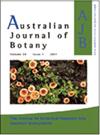澳大利亚与仙人掌科成员相关的黏菌门的首次记录
IF 0.9
4区 生物学
Q4 PLANT SCIENCES
引用次数: 0
摘要
上下文仙人掌是北美和南美的特有物种,但在欧洲人访问美洲后,许多物种已经传播到世界各地。它们在全球的传播影响了陆地生态系统的各个方面,包括肉质粘菌的分布。目的在本研究中,我们研究了粘霉菌(也称为浆状黏菌或粘胃菌)与澳大利亚引进的三种仙人掌的关系。方法采用湿室培养技术,从新南威尔士州和昆士兰州采集的三种仙人掌的尸体部位制备了33个培养物。关键结果88%的湿室培养物产生了黏菌的证据(胞浆体或子实体)。共记录了代表6个属的12个物种。压缩藻是最丰富的物种(出现在33种培养物中的20种中),像黄毛这样的物种也相对常见。我们还报道了在澳大利亚首次记录到的黄檗(Perichaena luteola)。结论这是首次研究与澳大利亚仙人掌科成员相关的黏菌群落,我们强调了肉质粘菌在该大陆的存在。本研究有助于更好地了解肉质粘菌的生物地理学、分布和生态学。我们还为澳大利亚增加了一个新的物种记录。本文章由计算机程序翻译,如有差异,请以英文原文为准。
First records of Myxomycetes associated with members of the Cactaceae in Australia
Context Cacti are endemic to North and South America, but numerous species have been spread all over the world after Europeans visited the Americas. Their global spread has impacted various aspects of terrestrial ecosystems, including the distributions of succulenticolous myxomycetes. Aims In this study, we examine the association of myxomycetes (also known as plasmodial slime moulds or myxogastrids) with three introduced species of cacti in Australia. Methods Using the moist chamber culturing technique we prepared 33 cultures from dead portions of three species of cacti collected in New South Wales and Queensland. Key results Eighty-eight percent of moist chamber cultures yielded evidence of myxomycetes (either plasmodia or fruiting bodies). A total of 12 species representing six genera were recorded. Physarum compressum was the most abundant species (appearing in 20 of the 33 cultures), with species such as Perichaena depressa also relatively common. We also report the first records of Perichaena luteola in Australia. Conclusions This is the first study to investigate the assemblages of myxomycetes associated with members of the Cactaceae in Australia, and we highlight the occurrence of succulenticolous myxomycetes on the continent. Implications This study leads to a better understanding of the biogeography, distribution and ecology of succulenticolous myxomycetes. We also add a new species record for Australia.
求助全文
通过发布文献求助,成功后即可免费获取论文全文。
去求助
来源期刊

Australian Journal of Botany
生物-植物科学
CiteScore
2.30
自引率
18.20%
发文量
26
审稿时长
6-12 weeks
期刊介绍:
Australian Journal of Botany is an international journal for publication of original research in plant science. We seek papers of broad interest with relevance to Southern Hemisphere ecosystems. Our scope encompasses all approaches to understanding plant biology.
Australian Journal of Botany is published with the endorsement of the Commonwealth Scientific and Industrial Research Organisation (CSIRO) and the Australian Academy of Science.
 求助内容:
求助内容: 应助结果提醒方式:
应助结果提醒方式:


